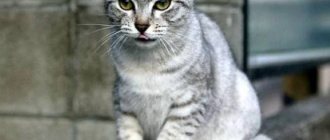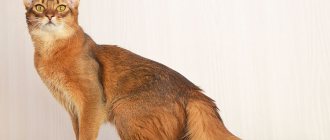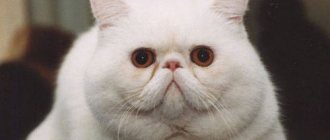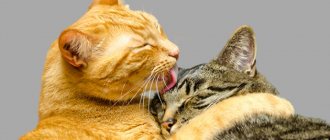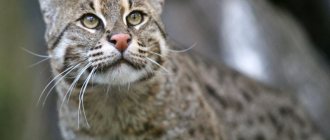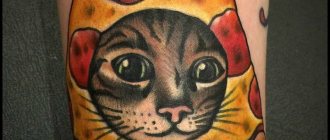Origin story
The first caracat was born in the Moscow Zoo at the end of the 20th century. One domestic cat was allowed to move freely around the zoo. She probably accidentally wandered into the enclosure of a caracal, and as a result of this meeting, an unusual kitten with a wild caracal color and tufts on her ears was born. The amazing story became public through the media and remained just news for some time. There was no thought about the development of the breed, besides, the born kitten is a boy, and male hybrids are sterile.
Attempts to breed caracats began in 2005 by the American breeder Joy Geisinger, who succeeded in obtaining results in 2007. By crossing a wild caracal and a domestic Abyssinian cat, the offspring of caracats was born. Soon the new hybrid breed was registered as experimental with TICA. But the history of the breed was not continued due to the death of the breeder.
The breed received a revival in Russia. A breeder from Ivanovo, as a result of painstaking work, managed to obtain offspring of caracats. The breed was soon recognized by the ICU.
Modern breeding programs allow the use of not only Abyssinian cats as females, but also cats of any breed suitable in type, color and size, for example, Chausie, Oriental and their crosses.
Health
All caraquets have very good health, which they inherited from the wild steppe cat. They are endowed with a good digestive system, which allows them to easily digest raw meat and bones. These animals are highly resistant to extreme conditions; they can go without food or water for a long time. Strong immunity makes your pet resistant to most feline diseases. At the same time, systematic comprehensive vaccinations against viral diseases and rabies must be carried out in a timely manner, especially if the caracat is taken outside for a walk. The life expectancy of cats of this breed has not been established, since the pets were bred quite recently. However, it is believed that the large animal lives several years less than the average domestic cat.
Peculiarities
First generation hybrids weigh 11-15 kg, second generation hybrids are smaller and weigh 9-10 kg. The height (at the withers) of adult individuals is 50 cm, and the body length is 90 cm. Moreover, the cats have an elegant physique.
Animals have a well-developed muscular system. They have strong and strong, fluffy paws, thanks to which the animals are able to make 3-meter jumps. The coat is short and thick, soft to the touch, uniform in color from light peach to dark red.
Distinctive features of the first generation hybrids are black ears, long sharp claws, and vocality. Their voice is more like a scream than a meow. Second generation hybrids lose these features.
Black ears with tassels at the tips are always alert. Animals have acute hearing; caracats are able to detect distant sounds.
Character of the caraquet
Affectionate and friendly, Caraquetas are ideal for families with children and the elderly. Animals are unusually smart and obedient. With the right approach to education, the caracat will not damage the furniture by sharpening its claws on it, will not jump on the dining table, and will quickly get used to the tray.
From childhood, animals retain curiosity and mobility, but do not become destructive. They love to play. Games often involve chasing a teasing toy and jumping. Like most cats, caraquets love to watch what is happening from above. Therefore, it is advisable to take care of purchasing a play set for cats so that the pet has the opportunity to splash out its energy without harming the furniture in the house.
Character and habits
Despite the fact that these cats are half wild animals, they are very friendly and gentle. They quickly become attached to their owner, very devoted and faithful. They are also quite intelligent and capable of learning. It is not difficult to accustom kittens to the tray. Adults respond well to training.
Belonging to the wild type is manifested in hunting habits. These pets are very playful and active. They love active games and will not refuse to run after the ball. It is necessary to devote enough time to active activities with your pet; such cats do not like to be lazy and sleep all the time.
Despite their hunting nature, they are non-aggressive. They do not attack people or damage property. Kittens hiss a lot, but this is more likely a manifestation of fear rather than aggression. In this way they try to protect themselves from the outside world.
Relationships with other pets have not been fully studied. However, representatives of the Caraquet breed show themselves to be friendly animals capable of mutual contact.
Maintenance and care
The soft and thick coat of the Caraquet requires care. It is enough to comb once a week, and during the molting period 2-3 times a week. In addition to a comb, it is convenient to use a rubber mitten for short-haired cats. It is enough to bathe animals once every 3 months. There are usually no problems with bathing, since caraquets love water and enjoy water procedures.
Nails are trimmed using special tools every 2 weeks. If you have a scratching post in the house, trimming the claws may not be necessary, since the animals will grind their claws down on their own.
Animals' ears should be regularly inspected and dirt removed to prevent unpleasant odor and ear diseases. Routine vaccinations and deworming will help avoid health problems. In spring, treatment against ectoparasites is recommended if the animal has access to the street.
Choosing a kitten and its cost
You should only purchase a purebred kitten from a trusted breeder. Here are the signs of a reliable nursery:
- it is registered in a large international felinological system;
- the breeder has a veterinary education or a certificate of completion of felinological courses;
- the nursery is a member of a club that can recommend it;
- it has its own website that provides contact information, as well as information about breeding animals, pedigrees, titles, expert ratings from exhibitions, etc.;
- has a good reputation and mostly positive reviews on forums and review sites;
- located in a spacious and clean house, equipped with everything necessary for a comfortable stay for animals: trays, scratching posts, beds, high-quality and fresh food, and a sufficient amount of clean water.
When the issue of choosing a nursery has been resolved, it’s time to think about purchasing an exotic friend:
- the kitten must be at least three months old - until this time it needs a cat mother: she feeds it with breast milk, thereby building the baby’s immunity;
Half-centimeter tassels on the ears of small caracats will appear by the month of life.
- teaches everything she knows: to wash herself, go to the litter box, overcome obstacles, hunt (at least her own tail);
- with clean eyes, ears and nose, without discharge or unpleasant odor;
- veterinary certificate and passport with deworming and vaccination marks;
The Caraquet is a difficult breed to breed, which explains its fabulous price - from 500 thousand rubles. up to 3 million rubles depending on the pedigree and generation of the hybrid. Currently, work on it is carried out in the following nurseries:
- KATALEYA (Krasnodar) and subsidiaries: VIVAT CARACAT (St. Petersburg);
- CARACAT ANGARA (Irkutsk);
- ALTAY-CARACAT (Barnaul).
Price
Hybrids separated into a new breed with an unusual appearance cost over 1.5 million rubles. The high price is due to the rarity of the breed. The breeding program involves a number of difficulties. It is not so easy to breed a large cat and a small cat. Caracals do not always perceive female domestic cats as partners and are in no hurry to mate. If the mating is successful, there is a high probability of stillborn kittens. Kittens born prematurely rarely survive. Viable F1 hybrids are the result of enormous efforts and financial investments, because large animals require maintenance costs, and therefore the price of animals is high.
History of the appearance of the species
The name of the new breed of cats, Caraquet, is made up of the name of the species of the parents. This is a wild daddy caracal and an ordinary domestic cat, just cat in English.
Wild cat Caracal
In 2005, America began breeding a new breed. The caracal kitten born to a domestic cat was the only one. There was no possibility of breeding a new breed. Boys in hybrid cats are infertile until the 5th generation. But the beautiful large cat, similar to a lynx, was remembered by cat lovers.
Breeders achieved success only in 2007. They received offspring from a caracal and an Abyssinian cat.
Currently, in the Moscow region there is a nursery of Irina Nazarova - KATALEYA, which breeds F1 caraquets. The caracal is domesticated. He belongs to the 3rd generation of domesticated animals. Abyssinian cats are specially selected for their genetic characteristics.
Specialists at the Krasnodar Zoo are breeding F1 caraquet kittens from a wild ancestor. There are no other places for breeding a new breed on the territory of the Russian Federation.
Mr. Cat recommends: why a real Caraquet is so rare
From the above it is absolutely clear that real domestic Caraquets simply do not exist in the world. Therefore, we will talk here only about hybrids from crossing a Caracal and a domestic cat of the first, second and third generations.
The offspring of the F1 generation are called first generation hybrids. These kittens have half the blood of a wild animal, all males are sterile. If a female from this litter is mated, for example, with an Abyssinian cat, then cubs of the second generation will be born - F2, which will contain 25% of the blood of the wild ancestor. Similarly, animals of the third, fourth and subsequent generations appear.
Usually, with each generation there is a decrease in predatory wild signs, both external and behavioral. The animal's ability to socialize also increases.
The first generation of females is the most valuable for breeders, since these females can become worthy mothers of new generations. Males, on the other hand, have an extremely bright and beautiful appearance, practically indistinguishable from Caracal, although they are not capable of producing offspring.
Often F1 females are bred again to a Caracal male to produce another strong generation of expectant mothers.
The first felinologists working on the new breed initially used Bengal cats as females, but here there is a high probability of getting kittens with a tabby color, although the “wild” features are enhanced. After all, Bengals themselves are hybrid individuals, obtained as a result of long breeding work by the American breeder Jean Mill with an Asian leopard cat.
So far, those kittens of the first, second and third generations of Caraquets that exist are mostly in nurseries (females) and continue breeding work. Males live as pets in the USA, Russia and some European countries. Therefore, finding a Caracat kitten is extremely difficult and is a very expensive purchase.
Description of the new cat breed Caracat
Kittens differ from their wild relatives only in size. They have pointed dark ears and a uniform color from light peach to dark red. As the kitten gets older, tufts appear on its ears. An adult caraquet has the following characteristics:
- triangular head;
- almond-shaped wild eyes of green and golden color;
- pointed, tasseled, dark ears with light fluff inside;
- dark rim on nose;
- there is a fat fold on the abdomen;
- wool has no smell;
- the lower part of the body is lighter than the back;
- long muscular legs.
Cats combine a predatory sparkle in their eyes and a soft, friendly character. The strong paws of an active animal and the scent of a predator. Muscular body 45 – 60 cm long, slender with a weight of 12 – 15 kg.
Color
The color of the caracat was borrowed from the wild caracal. There is ticking in the wool - dyeing each hair with three colors, light at the root and dark at the ends. It gives the impression of a slight haze.
A cross between a caracal and a domestic cat inherited a wild natural coat color
- wild – red-brown;
- chocolate – chocolate tips and red roots;
- cinnamon – red-brown on a light orange background;
- silver – on a silver background, color options range from brown to red.
Kittens may have small white spots on their bodies that disappear when they first molt. In adult cats, small lighter spots appear on the belly of the same color as the rest of the fur.
Animal keeping
An active and playful animal cannot be kept in a small apartment. Caraquet needs space. He actively moves around the house, runs, jumps. For the animal, it is necessary to install a playground with a scratching post and platforms at different heights.
Starting from 3 months, the kitten should be accustomed to walks. He must be taken out on a leash. The caracat may get scared or get playful and run away. Therefore, they should not be allowed to walk on their own.
In the house, the caraquet should have his own house, at a height. A cozy, enclosed place guarantees the animal safety and good visibility.
Cats have thick, short fur. She requires constant care. Cats need to be brushed daily during the molting period - in the spring. The rest of the time 2 – 3 times a week.
Cats need a lot of space for active movement, their own corner and a slide with a scratching post. The filler for the tray is selected experimentally, based on the taste of the animal.
Cats don't like being alone. They are sociable. If no one is home most of the day, they need a playmate. This could be a second cat or even a dog of medium and large breeds.
Nutrition
The growth and health of an animal is related to its nutrition. Particular attention should be paid to kittens. During the period of intensive growth, they should receive a set of minerals and vitamins. Experts have determined that the full range of nutrients necessary for caracals is found in quails and chicken heads. Babies begin to be given minced meat at one month of age, then meat with bones. At 6 months, the daily norm for a kitten is 3 quails.
The diet of such a pet should consist of natural food
At half a year the growth rate slows down. The diet includes raw beef, fish, and chicken. It eats exclusively raw meat, without heat treatment, 300 - 500 grams per day. Frozen meat should be warmed to room temperature. Poultry and fish bones are well processed by the animal's stomach.
Relation to water
The breed is unique. All cats are water-drinkers and the caracat is no exception. But he can not drink for 5 days, a kitten for up to 3 days. Their reserves of nutrients are stored in a fatty fold on the abdomen, like wild animals that no one feeds regularly and water must be found.
Animals are not afraid of water, they play with it and willingly bathe, especially in the shower. Cats need to be bathed once every 3 months.
Health of the Karakets
There is very little information about the quality of health of Carakets, some hereditary diseases, it’s just that the experimental breed is too young and lacks accumulated experience.
In any case, so far the few breeders have not encountered any problems. At the same time, when raising pets, it is very important to follow the same rules that apply to an ordinary domestic cat of any breed. It can be assumed that due to close wild blood, pets have very high immunity.
First of all, up to three months of age, primary and secondary anthelmintic treatments are carried out.
No earlier than ten days after it, the first comprehensive vaccination is given - against panleukopenia, rhinotracheitis, calcivirosis, chlamydia. It is also mandatory during revaccination (after two to three months) to simultaneously administer the drug Nabivak-Rabis against feline rabies. The next such vaccination is done after twelve months, then repeated annually.
Caracats should also be regularly treated for external parasites, because these pets usually regularly walk outside. This procedure is performed monthly; it is more convenient to use drops on the withers.
Do not forget about the rules of personal hygiene - be sure to treat entrance mats, houses, carriers (especially after visiting a veterinarian), beds, toys, bowls. Toilet trays should be washed daily with hot water and completely disinfected once a week.
Many responsible owners also regularly administer ringworm prevention medications, especially if the animal frequently attends shows.
So far, we can say that out of all eighty individuals, over the 15 years of the existence of the experimental Caraqueta breed, not a single case of an animal contracting any infectious disease has been noted.
A combination of calm and wild fire in the eyes
A distinctive feature of caracats is their high intelligence by cat standards. It manifests itself in the ability to quickly remember your name and rules of behavior in the house. The cat will not climb onto the table even for its favorite treat. It adapts to people's schedules and won't make noise at night when everyone is sleeping.
Caraquet cats are affectionate, friendly and extremely curious.
The Caraquet is the only cat breed with a calm character, obtained by crossing wild cats with domestic representatives.
They are distinguished by their friendliness and ability to get along peacefully with everyone. They quickly get used to all family members and especially love children. They do not conflict with dogs and willingly communicate and play with other cats. Parrots do not trigger their hunting instinct. Slow turtles are fun to play with.
Allergies of the Caraquet breed
A pet with a wild appearance not only does not suffer from allergies itself, thanks to good genetics, but also does not cause unpleasant symptoms in people. Over the years since the breeding of hybrids began, kittens have also been kept in families with allergies. But there have not yet been any cases of negative reactions to kittens from their owners. True, such a positive experience is not yet clear; research into the breed continues.
Caracat. The rarest cat in the world!
Peculiarities of breeding caraquets
Currently, F1 offspring are obtained by crossing a caracal and an Abyssinian cat. There is a maximum of 2 kittens in a litter. Boys are infertile until the 5th generation, which has not yet grown, therefore, to obtain the next generation, only Caraqueta cats are crossed with cats of other species. The breed is registered as experimental until the appearance of offspring with stable traits from 2 caraquets.
In case of a successful mating, 1-2 kittens are born, while the boys are always infertile
It is impossible to get F1 caracat kittens at home; you need a tamed caracal. The designation F and the number indicate which generation of caracal was crossed with a purebred cat:
- F1 – caracal and Abyssinian;
- F2 – F1 Caraquet cat and a cat of a certain breed selected according to genetic characteristics;
- F3 – F2 Caraquet cat and purebred cat.
We currently have F5 kittens available. They have little wild blood and have elements of other breeds in their external characteristics. The most beautiful and valuable caraquets F1.
The high cost is due to its rarity. A cat cannot have more than 2 kittens. It is difficult to obtain high-quality offspring by selecting animals based on genetics. Over time, when the breed is obtained consistently from cats of 5 and subsequent generations, the cost of animals will decrease, but it will not be small. The unique characteristics of the caraquet will always be valued.
Caracal - a wild and extremely expensive pleasure in your home
Power and elegance, exotic appearance and feline softness, and most importantly, charming ears with long tassels - all this is ideally combined in the Caracal breed. Large, tapering ears, with five-centimeter erect tufts of black wool, are the most unique feature of this cat. Caracals, despite the high cost of kittens and the peculiarities of their maintenance, are actively gaining popularity among cat lovers and exotic animals.
Historical reference
Cats of the Caracal genus live in the deserts and savannas of Africa, Central Asia, the Arabian Peninsula and the Caspian Sea coast since ancient times. It is believed that the historical homeland of this animal is Türkiye. The word Karakal means “black ears” in Turkish.
Since ancient times, steppe caracals have been tamed and used by the inhabitants of Asia and Africa.
- Excavations in Egypt have yielded paintings of caracals and bronze sculptures, as well as embalmed carcasses. This means that caracals occupied an important place in the life of the Egyptians.
- In China, emperors gave caracals as valuable gifts.
- In India, caracals have long been used for hunting small game.
- In Asia, this breed was used to help hunt game.
Interesting fact! In Iran, caracals were entertainment for wealthy gambling people. Animals were tamed, trained to hunt birds, and entered into competitions based on the number of birds caught in a jump.
The fact is that caracals are wonderful jumpers; they can jump up to 3 meters in the air to catch flying birds. Up to ten pigeons can be caught in this way at a time. The winner was the one whose cat knocked out the most birds from the jump. All these facts prove that the domestication of caracals is not something new, but rather began centuries ago.
Characteristics of the Caracal breed
Caracals stand out from other wild cats with their appearance. A cat that looks like a real desert lynx is the first impression this unusually beautiful animal makes. However, the caracal is not related to the lynx genus and morphologically the breed is more close to the puma.
The paws, thin body and tail are much longer than those of a true lynx, unusually elongated black ears with tassels, as well as a number of genetic differences made it possible to distinguish the Caracal into a separate genus. The African serval is also considered close to the caracal family.
Content Features
Since the caracal is still a wild predatory cat, there are difficulties in keeping it at home, namely:
- You cannot keep this type of cat in an ordinary apartment. You need a lot of space. Optimally - keeping in a private house with a fenced local area.
- To keep the animal outdoors, you will need to build an enclosure to the house - an extension of about 20 m2, with a fence height of 2.5 meters and above.
- The animal requires active walks and a lot of attention.
- The animal is thermophilic and does not tolerate cold.
- The pet will require high-quality nutrition and care, and accordingly, maintenance costs will be high.
- It is not advisable to have a caracal if children under 5 years old live in the house.
- If there are no plans for breeding, the pet must be sterilized before the age of 8 months, otherwise the animal will leave marks in your house.
- Caracals are difficult to litter train. If you succeeded, then you can proudly consider yourself an excellent trainer.
In the house where the caracal lives, everything should be cleaned as if a curious puppy lives there. The fact is that these cats are very playful, and after their games the house is turned upside down. Everything that can be attributed to a toy in one way or another will be mined, chewed, scratched and even partially eaten.
Games are the basis for the education and socialization of a young individual. Toys must be made of quality materials. Take the ones offered for large dogs.
Big cats love to swim, they swim and happily take water treatments as often as they are offered.
The claws on the paws must be trimmed in a timely manner. There must be a sufficient number of scratching posts in the house, otherwise the furniture will suffer significantly.
Nutrition
Particular attention should be paid to nutrition. As stated earlier, caracals are carnivorous predatory cats that hunt small animals, so they should mainly be fed raw meat. The diet is selected according to the breeder's recommendations.
Can be fed with high quality dry cat food. Nutrition should be balanced. The norm for food consumed per day is about 5% of the cat’s weight.
Attention! It is strictly forbidden to feed pig meat; pork causes Aujeszky's disease, the common name for this disease is “pseudorabies” or itchy plague. This disease almost always leads to the death of the animal. It is also necessary to exclude ready-made dishes “from the table”, spices in any form, salted and smoked foods.
Features of caraquet care
Caraquetas are specific cats that have non-standard sizes and physical characteristics that distinguish them from ordinary pets. This breed requires special conditions for maintenance, which are determined by their lifestyle. Physical activity and active games are important for them, so you should take care in advance of a “sports” area where the animal can surprise with its achievements. When purchasing a caraqueta, you need to know in advance everything about caring for it - from feeding to training methods.
Games
Under no circumstances should you use your own hands and feet when playing with a kitten, as a grown-up caracat can cause serious harm to its owner during play. The best toys for dogs to play with are all kinds of balls and swings. Feather blowers are only suitable for kittens under 3-4 months of age, after which the animal can easily destroy the toy in a matter of seconds. Give preference to everything durable, experimenting, and not leaving tools for games within the reach of the caraquet. If the toy is in sight all the time, the cat will quickly lose interest in it and will not be active.
Representatives of the breed have a good time at special sports complexes that are well fixed. Young caracats require systems consisting of low blocks, since the animal likes to jump not only forward, but also upward. Jumping too high can lead to injuries, so you need to increase the load and increase the size of the playing field in accordance with the age of the pet. Joint walks on the street will be beneficial, for which they use special reinforced harnesses that can withstand weight up to 15 kilograms.
To walk with a caracquet you will need a special harness designed for animals up to 15 kg
Hygiene
Despite their smooth coat, caracats must be systematically combed, at least once a week. In the summer they have a molting period and the cat will have to be brushed more often, preferably every day. You should not bathe a kitten more than once every three months, and after bathing it is important to make sure that the animal does not blow. As the caraquet gets older, water procedures can be carried out as needed, for example, after a walk outside. Exotic cats love water very much and resort to water procedures with pleasure.
Feeding
There are two strategies for feeding caraquets - feeding with dry food and feeding with natural products. When using store-bought food, you should give preference to formulations of the canvas class and buy those options that are intended for decorative, exotic and wild breeds of cats. The following foods are best suited for caracats:
- "Carnilove Lamb Wild Boar Sterilized";
- "ACANA Wild Prairie";
- "Carnilove Large Breed."
Breeders recommend feeding cats with natural products, combining meat, cereals, plant foods and milk. Caracats are fed mainly with meat - it can be turkey, quail, chicken, beef, rabbit. Products must be given raw; for your own peace of mind, you can pour boiling water over individual raw pieces. Babies up to six months are fed 3 times a day, from 6 to 12 months - 2 times, and starting from a year they are transferred to one meal a day. You can cook rolled oats, millet, and corn from cereals; buckwheat and rice are undesirable. Eggs, cottage cheese, vegetable fats are a must; you can add a small amount of olive or sunflower oil to the porridge.
The optimal amount of food consumed during the day should not exceed 5–7% of the animal’s weight. At first, while the caracat is still a baby, all food needs to be crushed by fine cutting, and starting from 6 months you can not worry about your pet, trusting it with large pieces. The animal must have clean water freely available; it is best to use filtered or bottled water. As for undesirable foods for caracats, these are:
- pork;
- pure cow or goat milk;
- fried foods;
- sweet;
- roots.
Toilet
Caracats are very smart animals; they easily get used to a tray with any filler, be it gel or wood. As a rule, the breeder himself trains the animal to use the toilet, and when purchasing a kitten, you receive a litter tray that the baby is already accustomed to. It is best if the tray is located close to the place where the domestic predator spends a lot of time. If there is a free room in the house, you will have to allocate it to the cat by installing a play set, a bowl for food and water, and a potty there. In most cases, there are no problems with caracats in terms of toilet training; they themselves find a tray and relieve themselves there. The main thing is not to forget to change the filler in a timely manner, since this exotic cat will not go into a dirty potty.
Caraquetas love cleanliness and easily find a litter tray in a new home.

